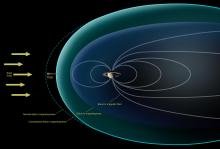Listen to today's episode of StarDate on the web the same day it airs in high-quality streaming audio without any extra ads or announcements. Choose a $8 one-month pass, or listen every day for a year for just $30.
You are here
Moon and Saturn
Saturn has more than 80 known or suspected moons, including several that are pretty big. And a recent study says it might have had another big one in the distant past. Named Chrysalis, it might have broken apart a hundred million years ago, forming Saturn’s rings.
Planetary scientist Jack Wisdom at MIT was intrigued by Saturn’s tilt on its axis. It’s a lot more severe than it should be. That means something must have knocked the planet over. The gravity of the giant planet Neptune could have done the job, but only under special conditions — perhaps provided by Saturn’s largest moon, Titan.
Titan is moving away from Saturn at about four inches per year. Simulations by Wisdom and colleagues showed that, as Titan moved outward, it changed a “wobble” in Saturn’s rotation. That brought Saturn and Neptune into sync, tilting Saturn over.
Chrysalis was orbiting between Titan and another moon. As Titan moved outward, the gravity of Titan and Chrysalis increased Saturn’s tilt even more. It also pushed Chrysalis into a more and more lopsided orbit. That eventually brought it so close to Saturn that it was ripped apart by the planet’s gravity. The debris spread out to form the rings.
That scenario matches many estimates of the age of the rings — evidence that Saturn’s rings could be debris from a vanished moon.
Saturn appears near our own moon at dawn tomorrow. It’s to the left of the Moon, and looks like a fairly bright star.
Script by Damond Benningfield





